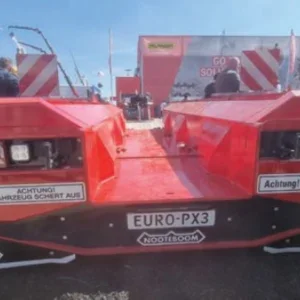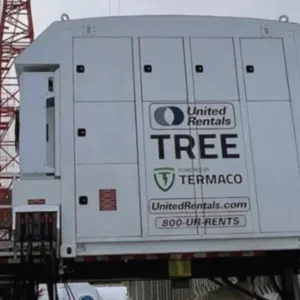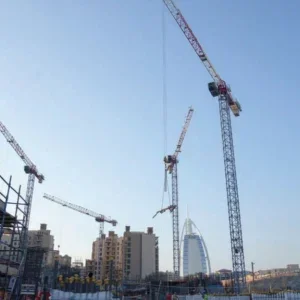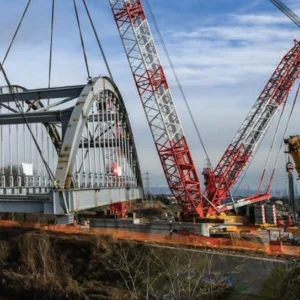According to German soccer legend Franz Beckenbauer, the 66,000 capacity Allianz Arena stadium will be ‘the most extraordinary the world has ever seen’.
When it opens in April 2005, the donut-shaped structure will be covered in a translucent ETFE skin, like the domes of the Eden Project in Cornwall, UK. The individual lozenges that make up the skin will light up either white, red or blue. Both Munich’s leading football teams, Bayern Munich and TSV 1860, will call the stadium home. For Bayern matches the stadium will be lit red, the team’s colour; for 1860 it will be blue. Designed by Swiss architects Herzog & de Meuron, working with main contractor Alpine Bau Deutschland, it promises to be quite a scene.
Construction has been tearing along since work on the E 280m project began on site in October 2002. It is a seven storey structure, including three tiers of spectator seating. Two-thirds of the terracing and seat rows were in place within a year. A workforce of 700, working in two shifts, placed 120,000m3 of concrete and 22,000t of steel within the first 365 days.
‘The pace and professionalism of the work here is absolutely incredible,’ says Beckenbauer, who is president of both the 2006 FIFA World Cup organizing committee and FC Bayern Munich.
The speed of work has been achieved thanks in no small part to 25 tower cranes on the site – 17 on the stadium itself and eight on the adjoining multistory car park structure. The car park, which will house 11,000 cars and covers a footprint of 55m by 140m, will be the largest in Europe, it is claimed. All eight cranes working on the concrete car park are Liebherrs – six 280 EC-H 12 models with 75m reach, a flat-top 280 EC-B 12 and a 256 HC. All eight run on 300mlong rail tracks on either side of the structure, helping to pour 1,450m3 of concrete every day.
On the stadium itself are 14 Liebherr tower cranes, with jib lengths ranging from 40m to 60m. There are also three Comedil flat-tops from the rental fleet of Zeppelin.
The highest crane on site is 79m under hook, according to site manager Stefan Wellstein. The Liebherrs on the stadium include five more 280 EC-H 12s, two flattop EC-B models and others from the EC, EC-H and HC series. All are free-standing, most are stationary but some are on undercarriages with travel gear.
Rental company Nagel-Mietservice supplied 12 Liebherr cranes: two 256 HC, ten 280 EC-H and one 280 EC-B. Liebherr dealer BKL Baukran Logistik provided two 280 EC-H cranes and one 180 EC-B. The other cranes used are from Alpine’s own crane fleet. The tower crane plan was carried out by Liebherr in collaboration with BKL, Nagel and Alpine.
Also at work, coming and going, are mobile cranes. The area that will become the pitch is dominated by two big crawler cranes – a 450t-capacity Demag CC 2500 belonging to Scholpp and a 250t Mantiwoc 999 owned by Helling. The Demag is used for lifting structural steelwork onto the top of the concrete bowl structure. The steelwork provides a frame for the ETFE skin. The Manitowoc 999 is helping to place some of the 2,400 prefabricated concrete sections, each 8m long and weighing 15.5t, that comprise the lower and middle stands.
Mobile crane rental company Schmidbauer has also had several cranes on site, from 40t up to 300t lifting capacity, doing general handling work and placing terracing elements. It also provided cranes, including a 160t Liebherr LR 1160 crawler, for the assembly of the tower cranes.
Liebherr reports that its cranes have also been seeing service on other football stadium projects in Germany, all being prepared for the World Cup. In Kaiserslautern, E48.3m is being spent upgrading the Fritz Walter stadium to increase capacity to 48,500. Two 550 EC-H 20 cranes and a 500 HC 40 are on site. The latter has a double trolley and is designed to lift precast concrete elements weighing up to 40t.
In Berlin Walter Bau and Dywidag have been renovating the old Olympic stadium since July 2000. Changes to the appearance of the stadium from the outside are being kept to a minimum, but the pitch is being lowered 2.65m so that more seats can be put in – capacity will be 75,065 – and a roof is being put over all seating areas. To date, seven Liebherr EC-H, EC and HC top-slewers have been on site, as well as a 63H self-erector.
By the time the World Cup starts, 12 stadiums will have been either newly built or brought up to world class levels. Improvement projects are also going on in Hanover and Cologne and are due to start soon in Stuttgart and Nuremberg. Dortmund’s improvement work has already finished. Completely new stadiums are being built in Frankfurt and Leipzig, as well as Munich, and have been completed in Hamburg and Gelsenkirchen.






